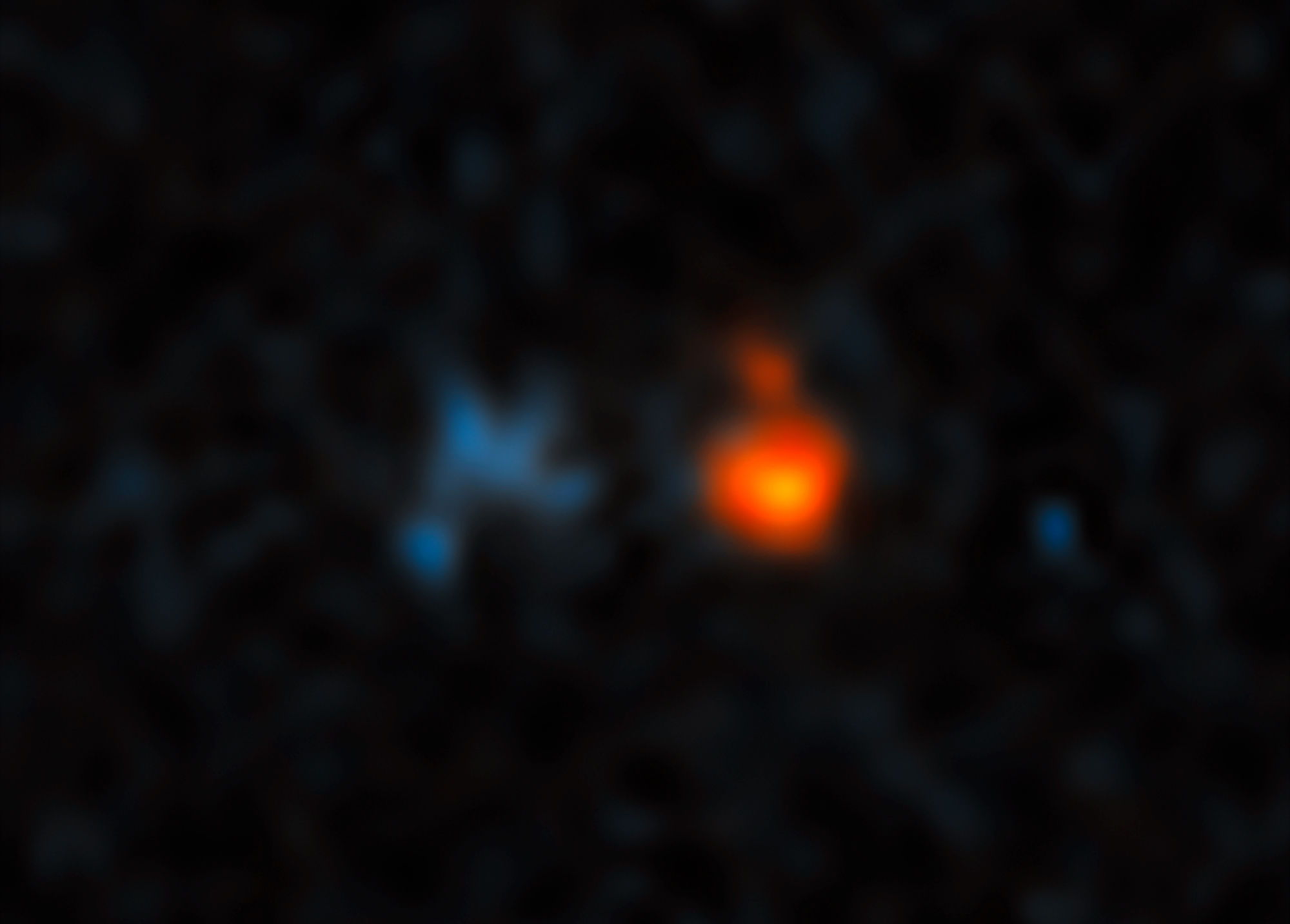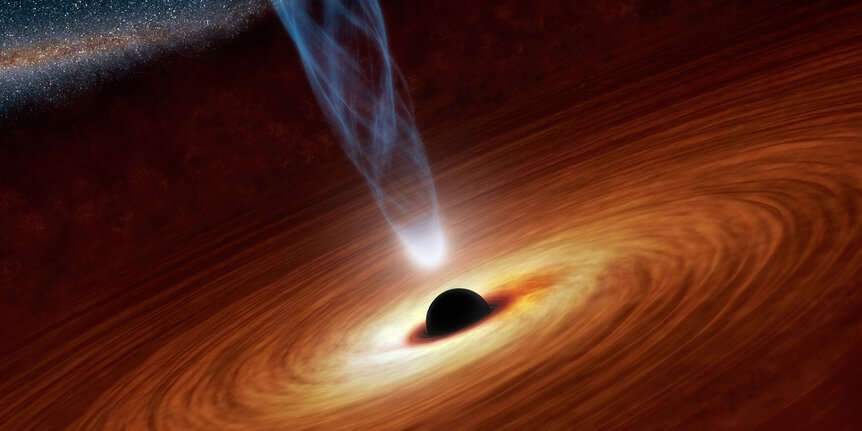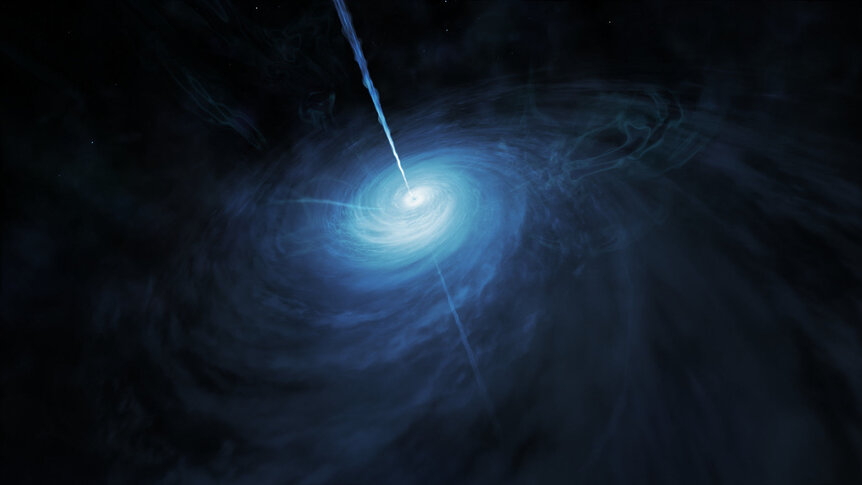Create a free profile to get unlimited access to exclusive videos, sweepstakes, and more!
A quasar at the edge of the observable Universe shines with the light of 10 *trillion* Suns

One of the nifty things about light is that it travels at a finite speed. Fast, yeah, but not infinitely fast. So if we look at some object that is very far away, we see it as it was when it was younger.
The Universe itself is only about 13.8 billion years old — heh, "only" — so we can't see anything farther away than 13.8 billion light years away, the distance light travels in that time. But we can see objects almost that far away. They have to have been very bright at the time, because that terrible distance dims them immensely, and most objects can't cut it.
But sometimes we do find celestial beacons at these remote locations. Not many, but some. A new one has just been found, and it's remarkable for many reasons. One is that it really is a phenomenally luminous object. Another is that it's so bright even though it was pretty young at the time its light left it. And a third is that even so, it would be invisible if its light weren't amplified by a gravitational trick.
The object is called J043947.08+163415.7 (I'll call it J043 for short), and it's a quasar. These are a kind of galaxy that blast out huge amounts of light due to a supermassive black hole in their centers. Every big galaxy has one, we think, including the Milky Way, but most are quiet. However, if some situation or event sends lots of gas sleeting into the black hole, it will pile up into a swirling disk just above The Point Of No Return. Friction in the disk will heat it hugely, with the material getting heated to millions of degrees. Gas this hot glows fiercely, making quasars some of the most continuously luminous sources of energy in the entire Universe.
They were more common in the early Universe; material left over from the galaxy's formation can fall to the center where the supermassive black hole awaits. However, at very large distances (and therefore seeing them when the Universe was young) we don't see as many as we expect. Either our models of how bright they can get aren't quite right (so very distant ones are still too faint to see), or else the way we look for them is flawed.
Going on the latter assumption, a team of astronomers tried something different. Usually, a quasar's colors give it away. They're brighter at some colors than others, so using filters when taking imaging surveys of the sky can detect them. They also tend to look red due to various phenomena (for example, material in between us and them absorbs blue light). But if there's a galaxy much closer to us that happens to fall along the same line of sight, it can make the quasar appear bluer, fooling software into thinking it's a normal galaxy.
Using different parameters to find distant quasars, the astronomers looked at data from various observatories that surveyed the sky, creating images deep enough to find distant quasars. That's when they found J043.
The distance they found for it (using its redshift) is a staggering 12.8 billion light years — J043 was shining brightly less than a billion years after the Universe itself formed!
But that's a problem. It's too bright. Even quasars shouldn't get as bright as J043. They decided to keep digging, using Hubble to observe the object. What they found suddenly made sense: a faint smear of a galaxy extremely close to the position of J043. The gravity of this intervening galaxy bends the light from J043 on its way to us, a process called gravitational lensing. This can have several effects on the quasar's light, including splitting it up into multiple images as well as magnifying its brightness.
Sure enough, the Hubble data show the quasar split into three different discrete spots, and also that the lensing amplifies its light by a factor of more than 50! Without the lensing effect, J043 would never have been found in the original observations. So that's pretty lucky.
Using models of how lensing works, the intervening galaxy is at a distance of about 6.4 billion light years from Earth. Still a long way — halfway across the visible Universe! — but still much closer than J043.
This means that J043 is emitting about 10 trillion times more light than the Sun does*. The lensing models indicate the black hole at its heart has a mass of about 400 million times the Sun's; for comparisons, the one at the center of the Milky Way is about 4 million.
This all makes J043 very important to astronomers. It's by far the brightest object ever seen at that distance, making it easier to observe (though not by any means easy; it's still pretty dang faint in the sky). It's not terribly well understood how objects that young can have such massive black holes; it takes time for them to grow huge, and hypotheses abound on how that could happen.
Also, the light we see from J043 was emitted at a special time in the young Universe's life, during a period called reionization. This is when such galaxies switched on, reheating cosmic gas that had been cooling since the Big Bang. It's hard to observe this time in cosmic history, and J043 is literally lighting the way for us. That's a huge boon to cosmologists.
Also, the fact that it exists at all means that there may be more objects like it waiting to be found. That's good news. First, it resolves the mystery of why we don't see them (they're out there, but their colors fooled us), and also it means that once we do start finding them we'll be able to probe the far distant Universe more effectively. Bigger telescopes will help, like James Webb (due to launch in 2020, we hope), as well as smaller telescopes that observe different kinds of light.
When I was a kid, reading books about quasars, the most distant one known was 3C273, a couple of billion light years away. It was the most distant object known. Now we know of thousands of quasars, with 150 of them more than about 12 billion light years away.
There are still so many more to be found, including ones perhaps even more distant and brighter than J043. When we do find them, our knowledge of the young cosmos will grow even more.
*I've seen some sources quote a figure of 600 trillion, but that doesn't account for the magnification by the lens, which makes it look brighter than it is.

















